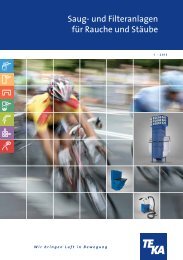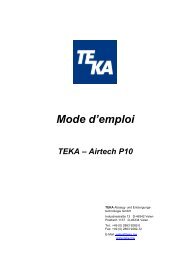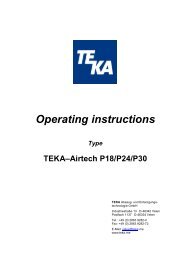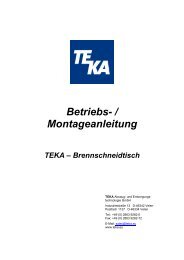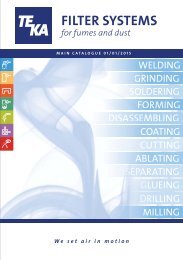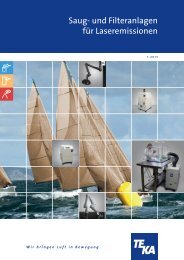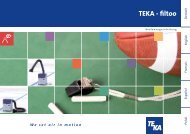Create successful ePaper yourself
Turn your PDF publications into a flip-book with our unique Google optimized e-Paper software.
2 Preface<br />
One sector of extraction equipment has become very significant in recent years. The filtering of<br />
extracted pollutants and the recycling of filtered air to the working area.<br />
This is a surely a sign that the environmental consciousness of every one of us has altered very strongly<br />
in favour of our environment. For a long time now, no one has denied that pollution occurs during<br />
production. However, the pollutants depend on the process that is used. One can basically distinguish<br />
between gases and fumes (smoke). Fumes could also really be described as dust. If you examine this<br />
dust under a microscope, you will find that they consist of very fine particles, often with a size of 1 µm or<br />
smaller, that can enter the lungs.<br />
The classical method of trying to improve the working conditions of polluted workplaces is general<br />
ventilation. In this case, the general rule is a multiple change of air in the workshop, i.e. the complete<br />
volume of air in the workshop is replaced. However, this method only achieves a small reduction in the<br />
level of pollution within the breathing space of the user.<br />
The same applies to “overhead”extraction, i.e. the installation of large extractor hoods above the<br />
workplaces. This is the worst airflow imaginable, since the pollutants first pass through the breathing<br />
space of the user, and only afterwards are they contained and extracted. This is surely not the point of<br />
the exercise. A much more effective method than overhead/wide-area extraction is the removal of<br />
pollutants directly at their source, with localised extraction. Both the investment and the operating costs<br />
are much, much lower if localised extraction is used.<br />
The environmental and workplace-safety measures are especially important requirements for successful<br />
application of a technology, in addition to the technological optimisation of the processing method. In a<br />
time of increasing sensitivity and tougher legislation, the task therefore lies in making an early<br />
assessment of the potential hazards for the workplace and the environment, and reducing them as<br />
appropriate.<br />
BA_Caremaster_091216_GB.doc - 5 - 2009-12-16



